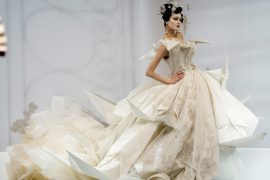How can we compare between the high-end brands and mass retailers’ development process of the seasonal collections?

I’ve always viewed the many collections created by brands as puzzles; designers would need all the essential parts comprising of said collection in order to present a successful offering by the time the show comes around. The process as a whole can be considered tough and full of pressure, not only for the designer but also for the entire team assisting in delivering the final product.
We break down the design process of high-end brands in this order: research, sketches, choosing fabrics, creating the first prototype, improving the finished piece until the desired outcome is achieved. Of course, for every design team the development process might differ – some use computer programs or software such as Browzwear or Optitex, while others might immediately work with patterns and begin creating structures.
Meanwhile, the design process of mass-market retailers can often be described as adapting the exact copies of designs originally produced by high-end brands. One of the most significant differences between the two is quality. Since mass-market retailers use low-quality fabrics and employ underpaid garment workers, they can cut down on costs and thus get the clothes to the stores far quicker than the high-end brands that originally produced the concept.
Accordingly, mass-market retailers such as Zara or H&M would set a lower price for the clothes, leading to higher profits. On the other hand, high-end brands would take a longer time to produce and distribute their collection, which is mostly sold in small quantities. Not to mention, not all the pieces that were initially presented in the high-end brands’ show are distributed to wholesalers, since they would need to employ more people with expertise in craftsmanship and fine tailoring in order to produce the exact same fine quality. In addition, high-end brands set the prices of the clothes on a high-range, often proving to be a repellent for consumers, especially when they have a low-cost alternative.
In terms of profit, mass-market retailers are doing better than their rival high-end brands. An example is a comparison between Zara and Ukrainian high-end brand Vyshyvanka by Vita Kin. The Ukrainian designer began gaining worldwide recognition when her vyshyvankas (Ukrainian national dress) were worn by iconic figures in the fashion industry like Anna Dello Russo and Miroslava Duma. Consequently, Zara began producing similar pieces in big quantities and set them at lower prices ranging from $70 to $120, compared to Vita Kin who sells them at higher prices, ranging from $1150 to $3500.
The struggle of high-end fashion brands who put so much work into their collections is mainly rewarded by critical praise in the industry and a good brand reputation, despite having competitors who duplicate their collections. As a result, high-end brands are opting to produce large quantities in order to distribute more worldwide, such as Parisian high-end brand Chanel, who in the past decade have opened stores in several airports worldwide.
Reference:



